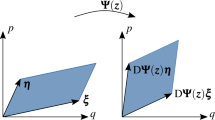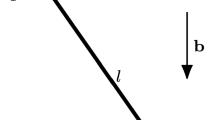Abstract
Every orthonomic system of partial differential equations is known to possess a finite number of integrability conditions sufficient to ensure the validity of them all. Here we show that a redundancy-free sufficient set of integrability conditions can be constructed in a time proportional to the number of equations cubed.
Similar content being viewed by others
References
J. Apel, R. Hemmecke, Detecting unnecessary reductions in an involutive basis computation, J. Symb. Comput. 40, 1131–1149 (2005).
G. Birkhoff, Lattice Theory, 3rd edn. (Am. Math. Soc., Providence, 1967).
A.V. Bocharov, V.N. Chetverikov, S.V. Duzhin, N.G. Khor’kova, I.S. Krasil’shchik, A.V. Samokhin, Yu.N. Torkhov, A.M. Verbovetsky, A.M. Vinogradov, Symmetries and Conservation Laws for Differential Equations of Mathematical Physics. Translations of Mathematical Monographs, vol. 182 (Am. Math. Soc., Providence, 1999).
F. Boulier, An optimization of Seidenberg’s elimination algorithm in differential algebra, Math. Comput. Simul. 42, 439–448 (1996).
B. Buchberger, Ein Algorithmus zum Auffinden der Basiselemente des Restklassenringes nach einem nulldimensionalen Polynomideal, Ph.D. Thesis, Univ-Innsbruck, 1965.
B. Buchberger, A criterion for detecting unnecessary reductions in the construction of Gröbner bases, in Proc. EUROSAM ’79, ed. by E.W. Ng. Lecture Notes in Computer Science, vol. 72 (Springer, Berlin, 1979), pp. 3–21.
M. Caboara, M. Kreuzer, L. Robbiano, Efficiently computing minimal sets of critical pairs, J. Symb. Comput. 38, 1169–1190 (2004).
J.-C. Faugère, A new efficient algorithm for computing Gröbner bases (F4), J. Pure Appl. Algebra 139, 61–88 (1999).
R. Gebauer, M. Möller, On an instalation of Buchberger’s algorithm, J. Symb. Comput. 6, 275–286 (1988).
V.P. Gerdt, Gröbner bases and involutive methods for algebraic and differential equations, Math. Comput. Model. 25, 75–90 (1997).
V.P. Gerdt, Yu.A. Blinkov, Involutive bases of polynomial ideals, Math. Comput. Simul. 45, 519–541 (1998).
G. Grätzer, General Lattice Theory (Akademie, Berlin, 1978).
W. Hereman, Review of symbolic software for Lie symmetry analysis, Math. Comput. Model. 25, 115–132 (1997).
E. Hubert, Notes on triangular sets and triangulation-decomposition algorithms II: Differential systems, in Symbolic and Numerical Scientific Computation, Proc. Conf. Hagenberg, ed. by F. Winkler, U. Langer, Austria, 2001. Lecture Notes in Computer Science, vol. 2630 (Springer, Berlin, 2003), pp. 40–87.
M. Janet, Leçons sur les Systèmes d’Èquations aux Derivées Partielles (Gauthier-Villars, Paris, 1929).
R.M. Karp, R.E. Tarjan, Linear expected-time algorithms for connectivity problems, J. Algorithms 1, 374–393 (1980).
B. Kruglikov, V. Lychagin, Mayer brackets and solvability of PDEs. I, Differ. Geom. Appl. 17, 251–272 (2002).
B. Kruglikov, V. Lychagin, Mayer brackets and solvability of PDEs. II, Trans. Am. Math. Soc. 358, 1077–1103 (2006).
W. Küchlin, A confluence criterion based on the generalised Newman lemma, in EUROCAL ’85, Proc. Conf. Linz, Vol. 2, ed. by B.F. Caviness, April 1–3, 1985. Lecture Notes in Comput. Sci., vol. 204 (Springer, Berlin, 1985), pp. 390–399.
M. Marvan, Sufficient set of integrability conditions of an orthonomic system: Extended abstract, in Global Integrability of Field Theories, Proc. GIFT 2006, Cockcroft Inst., Daresbury, ed. by J. Calmet, W.M. Seiler, R.W. Tucker, November 1–3, 2006 (Universitätsverlag, Karlsruhe, 2006), pp. 243–247. http://www.uvka.de/univerlag/volltexte/2006/164/pdf/Tagungsband_GIFT.pdf.
E. Miller, B. Sturmfels, Combinatorial Commutative Algebra, Springer Graduate Texts in Math., vol. 227 (Springer, New York, 2004).
P.J. Olver, Equivalence, Invariants, and Symmetry (Cambridge University Press, Cambridge, 1999).
J.F. Pommaret, Systems of Partial Differential Equations and Lie Pseudogroups (Gordon and Breach, New York, 1978).
G.J. Reid, Algorithms for reducing a system of PDEs to standard form, determining the dimension of its solution space and calculating its Taylor series solution, Eur. J. Appl. Math. 2, 293–318 (1991).
G.J. Reid, P. Lin, A.D. Wittkopf, Differential elimination-completion algorithms for DAE and PDAE, Stud. Appl. Math. 106, 1–45 (2001).
G.J. Reid, A.D. Wittkopf, A. Boulton, Reduction of systems of nonlinear partial differential equations to simplified involutive forms, Eur. J. Appl. Math. 7, 604–635 (1996).
C. Riquier, Les Systèmes d’Èquations aux Derivées Partielles (Gauthier-Villars, Paris, 1910).
C.J. Rust, Rankings of derivatives for elimination algorithms, and formal solvability of analytic PDE, Ph.D. Thesis, University of Chicago, 1998.
C.J. Rust, G.J. Reid, Rankings of partial derivatives, in Proc. ISSAC 1997 (ACM, New York, 1997), pp. 9–16.
C.J. Rust, G.J. Reid, A.D. Wittkopf, Existence and uniqueness theorems for formal power series solutions of analytic differential systems, in Proc. ISSAC 1999 (ACM, New York, 1999), pp. 105–112.
D.J. Saunders, The Geometry of Jet Bundles, London Math. Soc. Lect. Notes Series, vol. 142, (Cambridge Univ. Press, Cambridge, 1989–1929).
J.M. Thomas, Riquier’s existence theorems, Ann. Math. 30, 285–310 (1928).
A. Tresse, Sur les invariants différentiels des groupes de transformations, Acta Math. 18, 1–88 (1894).
A.M. Verbovetsky, I.S. Krasil’shchik, P. Kersten, M. Marvan, Homological Methods in Geometry of Partial Differential Equations (MCCME, Moscow, under preparation) (in Russian).
F. Winkler, Reducing the complexity of the Knuth–Bendix completion algorithm: a “unification” of different approaches, in EUROCAL ’85, Proc. Conf. Linz, Vol. 2, ed. by B.F. Caviness, April 1–3, 1985. Lecture Notes in Comput. Sci., vol. 204 (Springer, Berlin, 1985), pp. 378–389.
F. Winkler, B. Buchberger, A criterion for eliminating unnecessary reductions in the Knuth–Bendix algorithm, in Algebra, Combinatorics and Logic in Computer Science, Vol. II, ed. by J. Demetrovics et al. Coll. Math. Soc. J. Bolyai, vol. 42 (J. Bolyai Math. Soc., North-Holland, 1986), pp. 849–869.
F. Winkler, B. Buchberger, F. Lichtenberger, H. Rolletschek, Algorithm 628: an algorithm for constructing canonical bases of polynomial ideals, ACM Trans. Math. Softw. 11(1), 66–78 (1985).
A.D. Wittkopf, Algorithms and implementations for differential elimination, Ph.D. Thesis, Simon Fraser Univ., 2004.
T. Wolf, The integration of systems of linear PDEs using conservation laws of syzygies, J. Symb. Comput. 35, 499–526 (2003).
Author information
Authors and Affiliations
Corresponding author
Additional information
Communicated by Elizabeth Mansfield.
Rights and permissions
About this article
Cite this article
Marvan, M. Sufficient Set of Integrability Conditions of an Orthonomic System. Found Comput Math 9, 651–674 (2009). https://doi.org/10.1007/s10208-008-9039-8
Received:
Revised:
Accepted:
Published:
Issue Date:
DOI: https://doi.org/10.1007/s10208-008-9039-8




